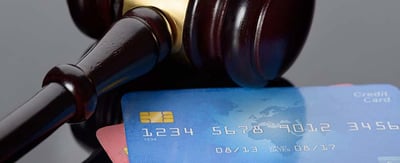
Introduction to Chargebacks 101
By Chris Alarie on Jul 21, 2021
The payments ecosystem is a complex creature, with so many essential facets that it can be difficult for a merchant to understand them all. Among the most important but most misunderstood aspects of this system are chargebacks. This article will provide a broad overview of the basic elements needed to understand chargebacks, including defining key terminology, explaining the chargeback dispute process, and outlining important procedures for preventing chargebacks.
The Basics: Q&A
What is a chargeback?
In our Payment Industry Glossary, we define a chargeback as follows:
A chargeback is a mechanism for returning payment to a customer after a disputed credit or debit card charge. Unlike a refund, a chargeback does not involve the direct communication of customer and merchant but, rather, involves communications between their respective banks (issuer and acquirer).
Ever since the passage of the Dodd–Frank Wall Street Reform and Consumer Protection Act in 2010, it has been significantly easier for consumers to request chargebacks. Combined with other factors such as the growth of e-commerce as a whole, this has led to a precipitous increase in the volume of chargebacks in recent years. Payment solutions giant Ethoca estimates that the value of chargebacks in the United States will increase from $6.1 billion in 2018 to $8.6 billion by 2021.
What are the consequences of chargebacks?
The most immediate consequence of chargebacks for merchants is that they cost money. If a customer files a chargeback, the issuer removes the money from the merchant’s account with the acquirer. Even if the chargeback is ultimately reversed and that payment is returned, the merchant will have to pay fees and operating costs related to the dispute process. But there are more significant potential costs related to a merchant’s chargeback ratio.
There is a metric known as a chargeback ratio which calculates chargebacks as a percentage of total transactions. If that ratio becomes too high for any merchant account, banks may impose restrictions on that account, up to and including closing the account entirely. The industry-wide, standard maximum chargeback ratio is 1% but banks and payment processors may have their own standards and requirements regarding chargeback ratios.
What is a MID?
A merchant identification number (MID) is a unique alphanumeric identifier that is assigned to a merchant account. It is used to identify the account at the various stages of processing a transaction. It is often used as a synecdoche for the merchant account itself.
A merchant account is, of course, the account that a merchant has with an acquirer that allows the merchant to process payment card transactions. The acquirer deposits funds received from issuers into the merchant account.
Merchants can sometimes have multiple MIDs and managing the chargeback ratio of its MIDs is an essential part of any merchant business.
What are reason codes?
Chargeback reason codes are alphanumeric codes that indicate the claimed reason for a chargeback. Each card brand has their own unique set of reason codes. For further information, see our article on chargeback reason codes and the lists of reason codes by card issuer.
What are the different kinds of fraud?
Fraud broadly falls into three different categories:
- True Fraud is when a credit card is stolen and used to make a purchase. True fraud usually results in the customer reporting the fraud to their bank, the bank closing the account, and the bank issuing a new card to the customer.
- Friendly Fraud is when a customer mistakenly disputes a charge for a relatively innocuous reason, such as a family member making a purchase without the customer realizing, the customer genuinely forgetting that they had made a purchase, or some mistake relating to the customer not understanding something such as a return policy. The key distinction is that the customer is not knowingly, intentionally committing fraud.
- Chargeback Fraud is when a customer requests a chargeback knowing that they have no valid claim to one. While friendly fraud results from an honest mistake, chargeback fraud is an intentional misuse of consumer protection mechanisms to get something for free. It is often used as a form of digital shoplifting.
Fighting Chargebacks
If a merchant believes that a chargeback is illegitimate, there is a form of recourse to pursue: the multi-forked path of dispute resolution. While dispute resolution differs depending on the procedures of the card brands and banks, it follows this general shape:
- First Presentment
The acquirer submits transaction data to the issuer to receive payment, which the issuer then remits. - Chargeback
The issuer disputes the transaction, and the payment from step 1 is removed from the acquirer’s account. - Second Presentment
The acquirer presents evidence to dispute the chargeback. - Pre-Arbitration Case Filing
The chargeback process having been completed; the issuer disputes some aspect of the second presentment. - Pre-Arbitration Response
Having received the case filing, the acquirer can either choose to accept or deny liability. If the acquirer accepts liability, the process ends here. If the acquirer does not accept liability, they rebut the case and send it to arbitration. - Arbitration
The issuer and acquirer each present their side of the case to Visa, who assigns responsibility. Whichever side loses is also required to pay all fees.
While this process can produce successful results for merchants, it is cumbersome. Even wins in pre-arbitration or arbitration will cost money in processing fees and operational costs. The far more effective and economical way to manage chargebacks is to try to prevent them.
For further information, see our articles about the pre-arbitration rules for Visa and Mastercard.
Preventing Chargebacks
A successful, comprehensive chargeback prevention program will approach the issue from multiple perspectives. While nothing can prevent chargebacks entirely—stuff happens—merchants who implement these strategies should likely receive fewer chargebacks than they would have without any such strategies.
Quality Goods and Services
The simplest way to reduce the likelihood that consumers will file chargebacks is to provide high-quality goods and services. A certain portion of chargebacks come from customers who are unsatisfied with their purchases and, for one reason or another, choose to file a chargeback rather than request a refund or otherwise communicate with the merchant. If a business is providing quality goods to consumers, there is a lower likelihood of this sort of customer dissatisfaction leading to chargebacks.
Accurate Description of Goods and Services
This is related to the previous strategy and mitigates a similar sort of “unsatisfied customer” chargeback. In these circumstances, rather than being unhappy with the quality of what they had purchased, the consumer discovers that the item does not match what they had expected when making the purchase. Again, for whatever reason, this confused consumer files a chargeback rather than requesting a refund.
A merchant can’t do anything to prevent a chargeback from a consumer who never contacts them. But they can reduce their likelihood of encountering these sorts of confused consumers by making a concerted effort to describe their products as clearly and accurately as possible. This principle applies to providing accurate descriptions of pricing structure, as well.
Providing Easy-to-Access and High-Quality Customer Service
Investing in quality customer service pays off well as a chargeback mitigation strategy. Well-trained customer service agents can turn potential chargebacks into refunds or even settle issues entirely, allowing the merchants to keep their revenue. Good customer service can allay consumer confusion and dissatisfaction relating to products, pricing, delivery, or other aspects of the purchase. Emphasizing customer service can also serve to manage consumers’ expectations, helping to prevent some of the situations described above.
Of course, good customer service is not useful if it is difficult for consumers to access. Customer service reps should be available through multiple channels—chat, text messaging, email, phone calls, etc. And the contact information for these various channels should be clearly presented in as many places as possible.
Customer service is one of the most important and effective chargeback prevention strategies because so many chargebacks originate from miscommunication and confusion. For further information, see our article on customer service chargebacks.
Over-Communicate with Consumers
While some merchants may be understandably wary of inundating their consumers with too many messages in fear of annoying them, the reality of life in the third decade of the 21st century is that we are all constantly awash in a sea of notifications. Merchants risk more by not communicating that they do by communicating too much. Consumers know how to tune out too many communications but they can’t conjure a necessary one that doesn’t exist.
Send confirmation emails when purchases are completed. Send messages to notify consumers when a product has shipped, providing any tracking information. Notify consumers if there are production or shipping delays or if a product is out of stock. Each new notification carries with it the possibility of preventing a chargeback.
Liberal Refund and Return Policies
While it may seem counterintuitive, it can often be in a merchant’s best interest to freely offer refunds when they are requested. Most refund requests are genuine and not pretext for fraud. And the ones that are fraudulent may not always be worth contesting. The time, effort, and costs spent fighting refund requests can outweigh whatever revenue may be recouped from successfully contesting the ones that are disingenuous.
A related policy that is useful is not requiring consumers to return empty containers or unused portions of consumable goods. While requiring products to be returned in exchange for granting refund requests may or may not be necessary, depending on the business, merchants are well served by reducing any unnecessary consumer friction related to refunds. Refunds are always preferable to chargebacks and every effort should be made to steer unsatisfied consumers toward refunds.
Liberal Cancellation Policies for Subscriptions
As with refunds, it may go against a merchant’s instincts to make it easy for consumers to cancel subscription billing accounts. But like refunds, a cancellation is vastly preferable to a chargeback. No merchant can ensure that every consumer will always be satisfied and should always steer those unsatisfied consumers to procedures that do not result in chargebacks.
Subscription-based merchants should send an email notification 7-10 days prior to billing with cancellation instructions. Cancellation requests should be processed as promptly as possible and subscription merchants should consider liberal policies with regards to returning merchandise. For further information, see our article on subscription billing and chargebacks.
Practice Affiliate Monitoring
Affiliate marketing can be a valuable tool for merchants. A solid roster of affiliates can provide otherwise unreachable sources of new customers and help integrate a merchant’s brand into a larger cosmos of trusted online merchants. But affiliate marketing can also bring risks if it results in working with dishonest or incompetent affiliates. A bad affiliate can harm merchants in numerous ways that could lead to chargebacks and brand damage.
In order to properly take advantage of the benefits of affiliate marketing, merchants must practice affiliate monitoring. For further information, see our article on affiliate monitoring.
Next Steps
Chargebacks are inevitable. Every merchant, even industrial giants like Amazon, must contend with them. But an excessive volume of chargebacks can potentially destroy a business. Among the consequences of too many chargebacks are lost revenue, brand damage, banking restrictions, and even the closing of MIDs. Understanding the sources of chargebacks, knowing the options for disputing chargebacks, and implementing strategies for managing and preventing chargebacks are essential parts of any merchant business.
The right chargeback management solution will provide you with the tools, information and insights you need to implement a solid chargeback management strategy.
Chargeback Management, Chargeback Prevention, Chargeback Reason Codes, Subscription Billing, Chargeback Fraud, Pre-Arbitration


